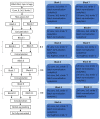Melanoma Classification Using a Novel Deep Convolutional Neural Network with Dermoscopic Images
- PMID: 35161878
- PMCID: PMC8838143
- DOI: 10.3390/s22031134
Melanoma Classification Using a Novel Deep Convolutional Neural Network with Dermoscopic Images
Abstract
Automatic melanoma detection from dermoscopic skin samples is a very challenging task. However, using a deep learning approach as a machine vision tool can overcome some challenges. This research proposes an automated melanoma classifier based on a deep convolutional neural network (DCNN) to accurately classify malignant vs. benign melanoma. The structure of the DCNN is carefully designed by organizing many layers that are responsible for extracting low to high-level features of the skin images in a unique fashion. Other vital criteria in the design of DCNN are the selection of multiple filters and their sizes, employing proper deep learning layers, choosing the depth of the network, and optimizing hyperparameters. The primary objective is to propose a lightweight and less complex DCNN than other state-of-the-art methods to classify melanoma skin cancer with high efficiency. For this study, dermoscopic images containing different cancer samples were obtained from the International Skin Imaging Collaboration datastores (ISIC 2016, ISIC2017, and ISIC 2020). We evaluated the model based on accuracy, precision, recall, specificity, and F1-score. The proposed DCNN classifier achieved accuracies of 81.41%, 88.23%, and 90.42% on the ISIC 2016, 2017, and 2020 datasets, respectively, demonstrating high performance compared with the other state-of-the-art networks. Therefore, this proposed approach could provide a less complex and advanced framework for automating the melanoma diagnostic process and expediting the identification process to save a life.
Keywords: classification; deep convolutional neural networks; melanoma; skin cancer.
Conflict of interest statement
The authors declare no conflict of interest.
Figures





Similar articles
-
Automated multi-class classification of skin lesions through deep convolutional neural network with dermoscopic images.Comput Med Imaging Graph. 2021 Mar;88:101843. doi: 10.1016/j.compmedimag.2020.101843. Epub 2020 Dec 24. Comput Med Imaging Graph. 2021. PMID: 33445062
-
Automatic lesion segmentation using atrous convolutional deep neural networks in dermoscopic skin cancer images.BMC Med Imaging. 2022 May 29;22(1):103. doi: 10.1186/s12880-022-00829-y. BMC Med Imaging. 2022. PMID: 35644612 Free PMC article.
-
Multiple skin lesions diagnostics via integrated deep convolutional networks for segmentation and classification.Comput Methods Programs Biomed. 2020 Jul;190:105351. doi: 10.1016/j.cmpb.2020.105351. Epub 2020 Jan 23. Comput Methods Programs Biomed. 2020. PMID: 32028084
-
Diagnosis and prognosis of melanoma from dermoscopy images using machine learning and deep learning: a systematic literature review.BMC Cancer. 2025 Jan 13;25(1):75. doi: 10.1186/s12885-024-13423-y. BMC Cancer. 2025. PMID: 39806282 Free PMC article.
-
Deep Learning Approaches Towards Skin Lesion Segmentation and Classification from Dermoscopic Images - A Review.Curr Med Imaging. 2020;16(5):513-533. doi: 10.2174/1573405615666190129120449. Curr Med Imaging. 2020. PMID: 32484086 Review.
Cited by
-
Classification of Skin Cancer Lesions Using Explainable Deep Learning.Sensors (Basel). 2022 Sep 13;22(18):6915. doi: 10.3390/s22186915. Sensors (Basel). 2022. PMID: 36146271 Free PMC article.
-
Distinguish the Value of the Benign Nevus and Melanomas Using Machine Learning: A Meta-Analysis and Systematic Review.Mediators Inflamm. 2022 Oct 14;2022:1734327. doi: 10.1155/2022/1734327. eCollection 2022. Mediators Inflamm. 2022. PMID: 36274972 Free PMC article.
-
Artificial Intelligence Algorithms for Benign vs. Malignant Dermoscopic Skin Lesion Image Classification.Bioengineering (Basel). 2023 Nov 16;10(11):1322. doi: 10.3390/bioengineering10111322. Bioengineering (Basel). 2023. PMID: 38002446 Free PMC article.
-
High-Precision Skin Disease Diagnosis through Deep Learning on Dermoscopic Images.Bioengineering (Basel). 2024 Aug 27;11(9):867. doi: 10.3390/bioengineering11090867. Bioengineering (Basel). 2024. PMID: 39329609 Free PMC article.
-
MSCDNet-based multi-class classification of skin cancer using dermoscopy images.PeerJ Comput Sci. 2023 Aug 29;9:e1520. doi: 10.7717/peerj-cs.1520. eCollection 2023. PeerJ Comput Sci. 2023. PMID: 37705664 Free PMC article.
References
-
- Leiter U., Eigentler T., Garbe C. Sunlight, Vitamin D and Skin Cancer. Springer; Berlin/Heidelberg, Germany: 2014. Epidemiology of skin cancer; pp. 120–140. - PubMed
-
- World Cancer Research Fund Skin Cancer Statistics. 2018. [(accessed on 15 December 2020)]. Available online: https://www.wcrf.org/dietandcancer/skin-cancer-statistics/
-
- International Agency for Research on Cancer Cancer—World Health Organization. 2020. [(accessed on 15 December 2020)]. Available online: https://www.who.int/cancer/PRGlobocanFinal.pdf.
-
- American Cancer Society Key Statistics for Melanoma Skin Cancer. 2021. [(accessed on 15 December 2020)]. Available online: https://www.cancer.org/cancer/melanoma-skin-cancer/about/key-statistics.....
MeSH terms
LinkOut - more resources
Full Text Sources
Medical

